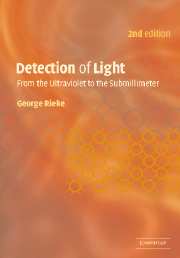Book contents
- Frontmatter
- Contents
- Preface
- 1 Introduction
- 2 Intrinsic photoconductors
- 3 Extrinsic photoconductors
- 4 Photodiodes and other junction-based detectors
- 5 Amplifiers and readouts
- 6 Arrays
- 7 Photoemissive detectors
- 8 Photography
- 9 Bolometers and other thermal detectors
- 10 Visible and infrared coherent receivers
- 11 Submillimeter- and millimeter-wave heterodyne receivers
- 12 Summary
- Appendices
- References
- Index
11 - Submillimeter- and millimeter-wave heterodyne receivers
Published online by Cambridge University Press: 09 November 2009
- Frontmatter
- Contents
- Preface
- 1 Introduction
- 2 Intrinsic photoconductors
- 3 Extrinsic photoconductors
- 4 Photodiodes and other junction-based detectors
- 5 Amplifiers and readouts
- 6 Arrays
- 7 Photoemissive detectors
- 8 Photography
- 9 Bolometers and other thermal detectors
- 10 Visible and infrared coherent receivers
- 11 Submillimeter- and millimeter-wave heterodyne receivers
- 12 Summary
- Appendices
- References
- Index
Summary
The general principles derived in Chapter 10 are equally valid for submillimeter- and millimeter-wave receivers. Performance attributes that limit the general usefulness of infrared heterodyne receivers, such as limited bandpass and diffraction-limited throughput, cease to be serious limitations as the wavelength of operation increases. Heterodyne receivers are therefore the preferred approach for high-resolution spectroscopy in the submillimeter spectral region, and their usefulness is expanded as the wavelength increases into the millimeter regime. At wavelengths longer than a few millimeters, they are used to the exclusion of all other kinds of detectors.
Basic operation
The operational principles of heterodyne receivers were described in Section 10.1, and the operation of the components that follow the mixer in a submillimeteror millimeter-wave receiver is essentially identical to the systems discussed in Chapter 10. Such components can be used for amplification, frequency conversion, and detection. Often, much of the expense in a heterodyne receiver system is in the “backend” spectrometer (for example, filter bank or autocorrelator) and in other equipment that processes the IF signal. Because these items can be identical from one system to another, it is common to use a single set of them as back ends with many different receiver “front ends” that together can operate over a broad range of signal frequencies.
- Type
- Chapter
- Information
- Detection of LightFrom the Ultraviolet to the Submillimeter, pp. 302 - 330Publisher: Cambridge University PressPrint publication year: 2002



